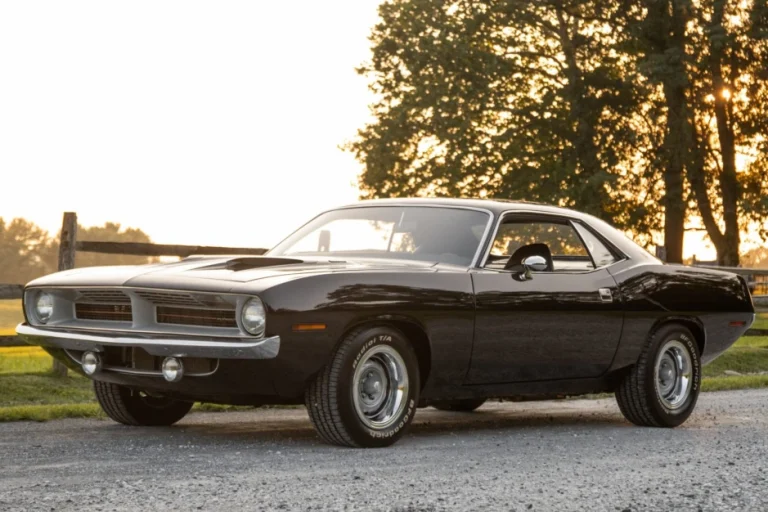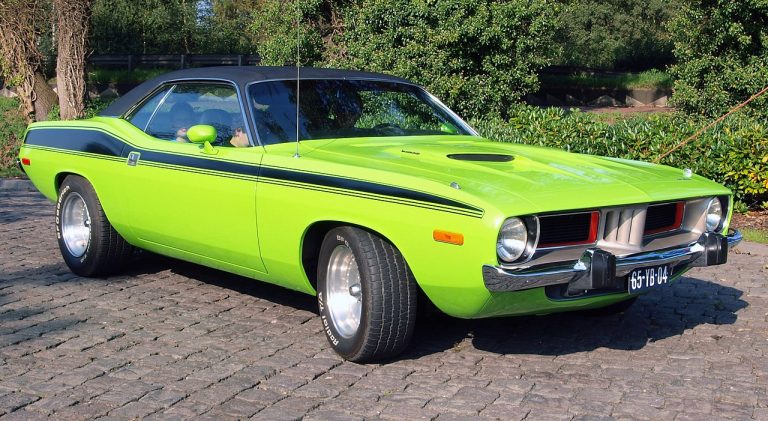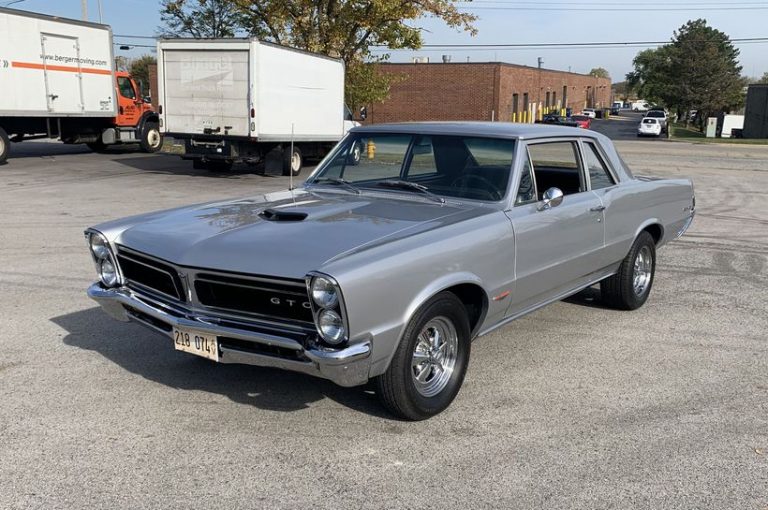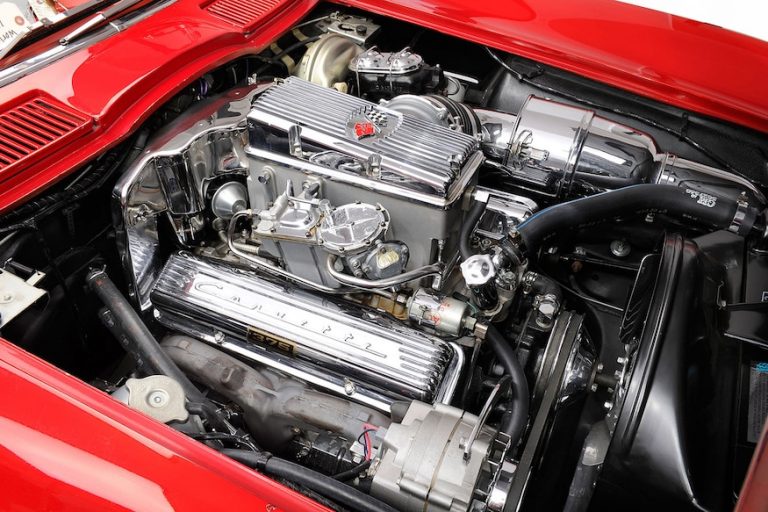Chevy Monte Carlo

Meet Chandler
Chandler has a bachelors and masters degree in history as well as a passion for classics and muscle cars. His education and historical knowledge makes him skilled at crafting highly detailed articles about America’s muscle cars and automotive history. His love of muscle cars is undeniable, with him seeking them out at every opportunity during his visits to auto shows and car meets. Chandler’s knowledge and enthusiasm towards automotive history make him a great asset to the Muscle Car Club community.
For fans of 1980s American muscle, there were few real options to choose from, but one of the top ones was the Chevy Monte Carlo. Introduced in 1970 just as muscle cars were at their height, the Monte Carlo stuck around until the late-80s, well after the shine of the era had worn off. Still, residing on the iconic General Motors G-body platform, the Monte Carlo SS offered style and moderate power in an era when, quite frankly, there was none. The final years of the car, from 1995–2007, finally brought back some of the performance from the early-1970s. Let’s take a look back at the legendary Chevy Monte Carlo, from 1970–2007.
Chevy Monte Carlo Overview
Chevrolet’s Monte Carlo spanned six generations and 32 model years, from 1970–2007. Chevy produced the car every year, except from 1989–1994 when they briefly retired it. Initially, GM positioned the Monte Carlo as a personal luxury car, similar to the Pontiac Grand Prix, Buick Gran Sport, and Buick Rivieras. From 1970–1971, buyers could opt for the SS package, which added a bigger engine and better suspension.
The earliest versions were truly the best, and only V8 power was available. Engines ranged from small-blocks to big-blocks, with 350 to 454 cubic inches in displacement. They put out as much as 360 horsepower and 500 lb-ft of torque in the SS. Unfortunately, by 1972 Chevrolet was already starting to cut power due to emissions, beginning a quick and steady decline.
The second generation lasted from 1973–1977, and power declined even further. The Monte Carlo got a little bit bigger and shifted to a new body style, and production grew substantially. From 1978–1980 and from 1981–1988 the third and fourth generations saw the last of the original Monte Carlo. Power bottomed out in 1978, when 145 horsepower was the highest output engine. However, this is also the year the car began using the G-body platform, which it shared with, among others, the Buick Grand National. Unfortunately, power hardly improved.
After a brief hiatus, the Monte Carlo returned in 1995, lasting until 2007. By the mid-2000s, power was finally back, with a supercharged V6 and the LS4 5.3 liter V8. As of 2023, the Monte Carlo namesake has still not returned, but we can only hope it will soon, preferably with an LT1 or LT2 under the hood.
First Generation 1970–1972 Monte Carlo
For many enthusiasts, the first generation of the Monte Carlo was the sweetest. It lasted from its debut in 1970 for three model years through 1972. It got some of the best V8 engines Chevrolet had to offer at the time, including the small-block 350 and big-block 402 and 454. The car rode on GM’s mid-size G-body platform with a 116 inch wheelbase, which it shared with the Pontiac Grand Prix.
Chevrolet developed the Monte Carlo as a longer and larger version of the Chevrolet Chevelle. They shared similar engines, including the legendary LS5 and LS6 454 V8s. The Monte Carlo also had an absolutely massive hood, the longest in Chevy history, and was only available as a two-door hardtop coupe. According to official Chevrolet literature, “If [Chevrolet] are guilty of any extravagance inside Monte Carlo, it is only for your well-being and comfort.”
1970 Monte Carlo
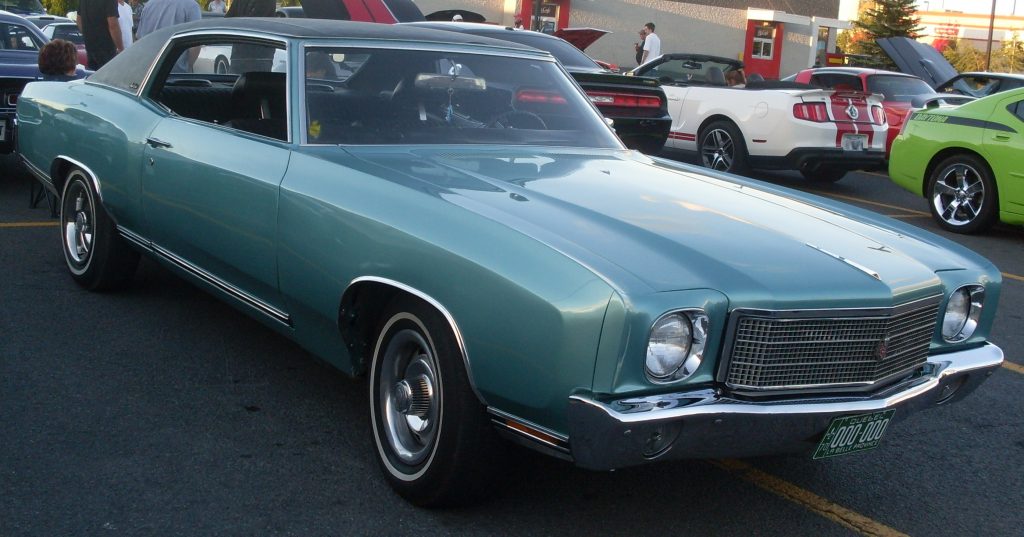
Chevrolet debuted the 1970 Monte Carlo in September 1969, and they based it on the Chevelle but made it longer with more standard options. It weighed 3,460 pounds and cost $3,123 with standard equipment, slotting it between the Camaro and the Chevelle in terms of pricing. The Monte Carlo rode on the G-body and sold reasonably well, with 145,975 units going out to customers.
Available engines included the small-block 350 and 400 V8s, as well as the big-block 402 and 454 V8s. The 350 was offered with both double and quad-barrel options, and made 250-300 horsepower. The next step up 400 V8 (RPO L48) made just 265 horsepower, but a healthy 400 lb-ft of torque. The big-block 402 was available with 330 horsepower (RPO LS3). It had 10.25:1 compression, hydraulic lifters, nodular iron crank, and a quad-barrel carb.
However, the top of the line was the 454 big-block V8. It was only available with the SS package, which also included heavy duty suspension and special SS 454 badging. The less powerful version was the LS5, which made 360 horsepower through 10.25:1 compression, hydraulic lifters, dual exhausts, and a four-barrel carb.
The most powerful engine was the LS6, which made 450 horsepower through 11.25:1 compression, solid lifters, a high-lift aggressive camshaft, and Holley 780-cfm four-barrel carb. It’s thought that only 10 of the LS6 powered Monte Carlos were ever built, though even that is disputed by some who claim it never got the engine at all.
1971 Monte Carlo

The Monte Carlo returned for 1971, only now it was a little less mean. Emissions restrictions were already forcing detuning of the engines due to lower compression ratios. This meant lower horsepower numbers across the board. The only exception was the LS5 454, which now made 365 horsepower — but dropped 35 lb-ft of torque.
The LS6 is listed as being available in factory literature, though it’s unclear if any were actually built, and it was down to 425 horsepower anyways. Still, the SS package remained popular. Chevy gave it a new blacked-out rear body panel and better suspension with stabilizer bars in the front and rear.
1972 Monte Carlo

For the 1972 Monte Carlo, Chevrolet basically carried everything over from the year prior. The only change was to the engines, which now used SAE Net instead of SAE Gross ratings. Actual power output was about the same, but Net ratings chopped off a ton on paper. What was 245 horsepower now just looked like 165 horsepower, and even the LS5 454 now only produced 270 horsepower. This was the last year of the Monte Carlo’s glory days as a muscle car, and the rest of the ‘70s was all downhill from there.
1970–1972 Monte Carlo Engines
| Model Year | Engine | Horsepower | Torque |
| 1970 | 350 V8 (2bbl) | 250 horsepower | 345 lb-ft |
| 1970 | 350 V8 (4bbl) | 300 horsepower | 380 lb-ft |
| 1970 | 400 V8 (2bbl) | 265 horsepower | 400 lb-ft |
| 1970 | 402 V8 (4bbl) | 330 horsepower | 410 lb-ft |
| 1970 | 454 V8 (4bbl) | 360 horsepower | 500 lb-ft |
| 1970 | 454 V8 (4bbl) | 450 horsepower | 500 lb-ft |
| 1971 | 350 V8 (2bbl) | 245 horsepower | 350 lb-ft |
| 1971 | 350 V8 (4bbl) | 270 horsepower | 360 lb-ft |
| 1971 | 402 V8 (4bbl) | 300 horsepower | 400 lb-ft |
| 1971 | 454 V8 (4bbl) | 365 horsepower | 465 lb-ft |
| 1971 | 454 V8 (4bbl) | 425 horsepower | 475 lb-ft |
| 1972 | 350 V8 (2bbl) | 165 horsepower | 280 lb-ft |
| 1972 | 350 V8 (4bbl) | 175 horsepower | 280 lb-ft |
| 1972 | 402 V8 (4bbl) | 240 horsepower | 345 lb-ft |
| 1972 | 454 V8 (4bbl) | 270 horsepower | 390 lb-ft |
1970–1972 Monte Carlo Production Numbers
| Model Year | Body Style | Production Total |
| 1970 | Monte Carlo | 145,975 |
| 1971 | Monte Carlo | 112,599 |
| 1972 | Monte Carlo | 180,819 |
Second Generation 1973–1977 Monte Carlo
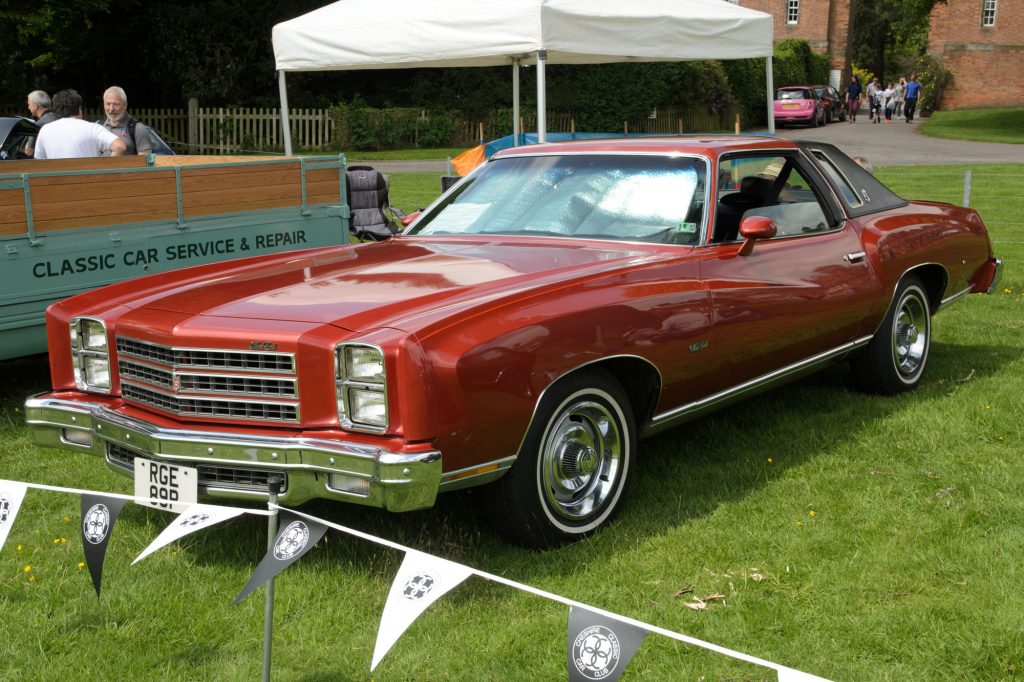
The second generation of the Monte Carlo lasted from 1973–1977, at the height of the muscle car malaise era. The biggest news for the Monte Carlo was its switch to the new A-body special. It shared this with the Chevrolet Chevelle, Chevrolet El Camino, Oldsmobile 4-4-2, Pontiac Grand Prix, Pontiac LeMans GTO, and others. It still had the same 116 inch wheelbase, but was about 6 inches longer overall.
The platform no longer used a hardtop, as a Colonnade pillared coupe replaced the old body style. It had a new front bumper, roll bars as standard, new tires, shock absorbers, and even more improvements for handling. The SS option was still not available, as now the trims were the S coupe or the Landau coupe.
The 1973 Monte Carlo actually earned Motor Trend’s “Car of the Year” award, which praised its power and handling. The 1974 Monte Carlo featured a new egg-crate grille, a medallion on the front hood lip, a new rear bumper, and new tail light designs. The next few years saw changes once again to the grille, as well as new stacked headlights, taillights, and it also became boxier overall. The Colonnade style body remained, and in 1977 received new front springs and an improved radiator.
Engine-wise, the small-block 350 and 400 both remained, along with the big-block 454, albeit all of them in detuned fashion. The 454 still lasted through 1975, when it only made 215 horsepower but a still solid 350 lb-ft of torque. By 1977, the only engine available was the 350, making 145-170 horsepower. Even with the detuned engines, production still soared, reaching an all-time peak of 410,000 in 1977.
1973–1977 Monte Carlo Engines
| Model Year | Engine | Horsepower | Torque |
| 1973-1977 | 350 V8 (2bbl) | 145 horsepower | 255 lb-ft |
| 1973 | 350 V8 (4bbl) | 175 horsepower | 260 lb-ft |
| 1973 | 454 V8 (4bbl) | 245 horsepower | 375 lb-ft |
| 1974 | 350 V8 (4bbl) | 160 horsepower | 245 lb-ft |
| 1974 | 400 V8 (2bbl) | 150 horsepower | 295 lb-ft |
| 1974 | 400 V8 (4bbl) | 180 horsepower | 290 lb-ft |
| 1974 | 454 V8 (4bbl) | 235 horsepower | 360 lb-ft |
| 1975 | 350 V8 (4bbl) | 155 horsepower | 250 lb-ft |
| 1975-1976 | 400 V8 (4bbl) | 175 horsepower | 305 lb-ft |
| 1975 | 454 V8 (4bbl) | 215 horsepower | 350 lb-ft |
| 1976 | 350 V8 (4bbl) | 165 horsepower | 260 lb-ft |
| 1977 | 350 V8 (4bbl) | 170 horsepower | 270 lb-ft |
1973–1977 Monte Carlo Production Numbers
| Model Year | Body Style | Production Total |
| 1973 | Monte Carlo | 233,689 |
| 1974 | Monte Carlo | 312,217 |
| 1975 | Monte Carlo | 258,909 |
| 1976 | S Coupe | 191,370 |
| Landau Coupe | 161,902 | |
| 1976 Total | 353,272 | |
| 1977 | S Coupe | 224,327 |
| Landau Coupe | 186,711 | |
| 1977 Total | 411,038 |
1978–1988 Monte Carlo
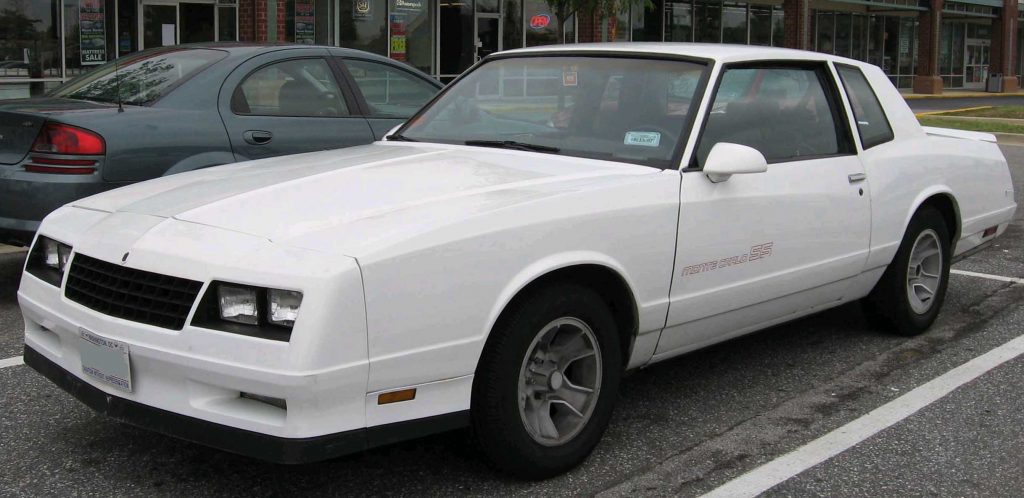
The third generation Monte Carlo lasted from 1978–1980, with the fourth generation continuing through 1988. The 1978 Monte Carlo returned to the G-body. This meant it was 800 pounds lighter and 13 inches shorter, with an 8 inch shorter wheelbase. Yet, it was also a bit taller and the interior was more spacious. The entire model was much more square and boxy than before, with larger quarter windows and frameless doors.
The 1979 Monte Carlo was largely the same, except with a new grille, wraparound side marker lamps, and new taillights. The next year, the 1980 Monte Carlo Turbo became available. Using the first turbocharged engine for the platform, the Buick 231 cid (3.8 l) V6, it was a decent hit with buyers.
For the fourth generation, it briefly switched back to the A-body for 1981 only, pivoting to the G-body once again for 1982-on. In the 1982 Monte Carlo, the Landau model disappeared, and only the sport coupe was available. The SS package returned with the 1983 Monte Carlo SS, and it was a hit with buyers. Once again, it included some better suspension, a rear spoiler, new wheels and tires, and an upgraded interior.
In 1986, Chevrolet introduced the Luxury Sport (LS) model to complement the sport coupe, but that wasn’t the real news. That was the Monte Carlo SS Aerocoupe, which only lasted from 1986–1987. Chevy designed and used the Aerocoupe for NASCAR, where it put up 18 wins and was extremely popular. The street version had an upgraded suspension, differential, brakes, and pretty much everything else.
The Slow Decline
Overall, production was down severely from the pre-third generation 1970s, and it never recovered. After maintaining sales above 300,000 through 1979, things halved the next year in 1980. For much of the decade, they were hovering right around 100,000 units, but things cratered to a halt in 1988. That year, barely 30,000 were sold, and most of them were 1987 carryovers.
Third and Fourth Generation Engines and Performance
For the third and fourth generations, Chevy really downsized things. In the 1978 Monte Carlo, the main power plant was a 231 V6, making 105 horsepower. A V8 option was still offered, but was pretty anemic at 145 horsepower. The Monte Carlo Turbo used a turbocharged 3.8 liter version of the same V6 from Buick. It made a generation high of 170 horsepower and 165 lb-ft of torque.
From 1982–1984, diesel options were briefly available. These were a 4.3 V6 and a 5.7 V8, both of which used direct injection instead of carburetors. These were not super popular options, these are Monte Carlos we’re talking about here, and they were less powerful and made less torque than the gas options.
In 1985, a throttle-body injection 4.3 V6 making 130-140 horsepower and 210 lb-ft of torque became an option, but paled to the 5.0 V8 making 175-180 horsepower.
Trailer Park Boys Monte Carlo
Fans of the show “Trailer Park Boys” undoubtedly remember Julian’s 1981 Monte Carlo. Julian’s Monte Carlo was likely the 5.0 V8 powered version, putting down all of 155 horsepower — but 230 lb-ft of torque, enough for some tasty burnouts. Of course, Julian’s model was also custom-built with a hockey-stick spoiler, which you really can’t price.
1979–1988 Monte Carlo Engines
| Model Year | Engine | Horsepower | Torque |
| 1978 | 231 V6 (1bbl) | 105 horsepower | 185 lb-ft |
| 1978 | 305 V8 (2bbl) | 145 horsepower | 245 lb-ft |
| 1979 | 3.3L V6 (1bbl) | 94 horsepower | 154 lb-ft |
| 1979-1980 | 3.8L V6 (1bbl) | 115 horsepower | 190 lb-ft |
| 1979 | 4.4L V8 (2bbl) | 125 horsepower | 215 lb-ft |
| 1979 | 5.0L V8 (4bbl) | 160 horsepower | 235 lb-ft |
| 1980 | 3.8L V6 (Turbo) (4bbl) | 170 horsepower | 265 lb-ft |
| 1980 | 4.4L V8 (2bbl) | 120 horsepower | 215 lb-ft |
| 1980 | 5.0L V8 (4bbl) | 155 horsepower | 230 lb-ft |
| Fourth Generation | |||
| 1981-1984 | 3.8 V6 (1bbl) | 110 horsepower | 170 lb-ft |
| 1981 | 3.8 V6 (Turbo) (4bbl) | 170 horsepower | 265 lb-ft |
| 1981-1982 | 4.4 V8 (2bbl) | 115 horsepower | 200 lb-ft |
| 1981 | 5.0 V8 (4bbl) | 150 horsepower | 240 lb-ft |
| 1982 | 5.0 V8 (4bbl) | 145 horsepower | 240 lb-ft |
| 1982-1983 | 4.3 V6 (Diesel) (DI) | 85 horsepower | 165 lb-ft |
| 1982-1984 | 5.7 V8 (Diesel) (DI) | 105 horsepower | 200 lb-ft |
| 1983-1988 | 5.0 V8 (4bbl) | 150 horsepower | 240 lb-ft |
| 1983 | 5.0 V8 (4bbl) | 175 horsepower | 235 lb-ft |
| 1984-1988 | 5.0 V8 (4bbl) | 180 horsepower | 235 lb-ft |
| 1985 | 4.3 V6 (TBI) | 130 horsepower | 210 lb-ft |
| 1986 | 4.3 V6 (TBI) | 140 horsepower | 225 lb-ft |
| 1987-1988 | 4.3 V6 (TBI) | 145 horsepower | 225 lb-ft |
1979–1988 Monte Carlo Production Numbers
| Model Year | Body Style | Production Total |
| 1978 | S Coupe | 216,730 |
| Landau Coupe | 141,461 | |
| 1978 Total | 358,191 | |
| 1979 | S Coupe | 225,073 |
| Landau Coupe | 91,850 | |
| 1979 Total | 316,923 | |
| 1980 | S Coupe | 116,580 |
| Landau Coupe | 32,262 | |
| 1980 Total | 148,842 | |
| Fourth Generation | ||
| 1981 | S Coupe | 149,659 |
| Landau Coupe | 38,191 | |
| 1981 Total | 187,850 | |
| 1982 | Monte Carlo V6 | 53,932 |
| Monte Carlo V8 | 38,459 | |
| 1981 Total | 92,391 | |
| 1983 | Monte Carlo V6 | 50,973 |
| Monte Carlo V8 | 40,632 | |
| Monte Carlo SS | 4,714 | |
| 1983 Total | 96,319 | |
| 1984 | Monte Carlo V6 | 58,786 |
| Monte Carlo V8 | 53,945 | |
| Monte Carlo SS | 24,050 | |
| 1984 Total | 136,781 | |
| 1985 | Monte Carlo V6 | 63,512 |
| Monte Carlo V8 | 20,061 | |
| Monte Carlo SS | 35,484 | |
| 1985 Total | 119,057 | |
| 1986 | Monte Carlo Base | 50,418 |
| Monte Carlo LS | 27,428 | |
| Monte Carlo SS | 41,164 | |
| 1986 Total | 119,010 | |
| 1987 | Monte Carlo Base | 16,232 |
| Monte Carlo LS | 39,794 | |
| Monte Carlo SS | 39,251 | |
| 1987 Total | 95,277 | |
| 1988 | Monte Carlo V6 | 13,970 |
| Monte Carlo V8 | 16,204 | |
| 1988 Total | 30,174 |
1995–2007 Monte Carlo
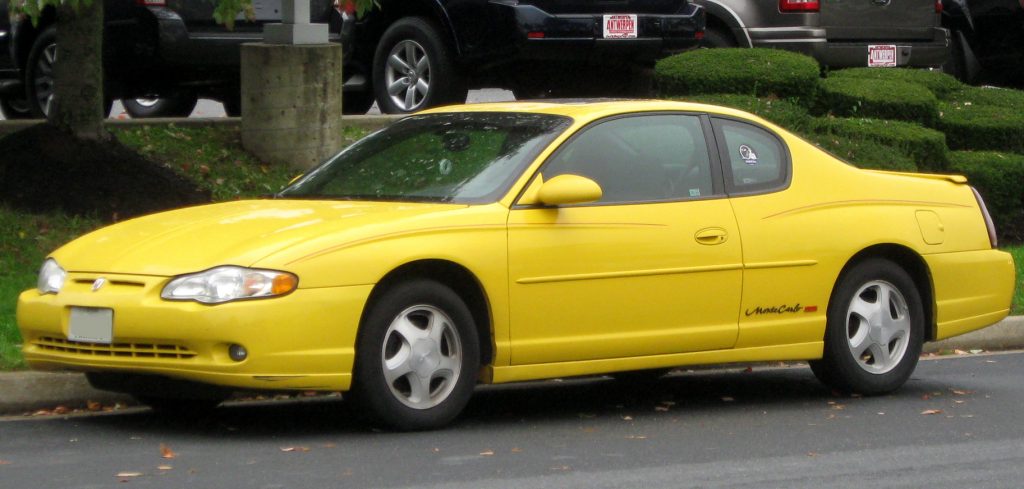
After a six-year hiatus, the Monte Carlo returned in 1995. It rode on the W-body platform now, which it once again shared with the Pontiac Grand Prix. This meant the Monte Carlo was now front-wheel drive for the first time ever, which didn’t exactly lend itself to improved performance. By now, the Monte Carlo was a complete shell of its muscle car self, but offered adequate performance for 1990s economy.
Available trims were the LS or the Z34, and it was also used as the Brickyard 400 Pace Car, with Chevy building around 400 replicas. The LS used a 3.1 V6 that pushed out 160 horsepower, while the Z34 got a more powerful 3.4 V6 at 210–215 horsepower. In 1998, a 3.8 V6 replaced the 3.4, but dropped to 200 horsepower. All engines were now electronically fuel injected instead of carbureted or throttle-body injected.
The final sixth generation Monte Carlo lasted from 2000–2007, and saw a belated return to performance. It was still on the W-body platform, but now had a stretched deck-lid and decklid spoiler. Back for the first time since the 1980s was the SS option, which included a supercharged 3.8 V6 (starting in 2004).
In the 2006–2007 Monte Carlo SS, the 5.3 LS4 V8 was also an option. This was the first Monte Carlo to crack 300 horsepower since 1971, but handled much differently due to the new front-wheel drive platform. Unfortunately, even the supercharged and LS4-powered Monte Carlo SS were not enough to keep it afloat, and Chevy once again canceled it after 2007. The Monte Carlo SS still lives on today in the hearts of muscle car enthusiasts everywhere, and we all still want to see an LT1 or LT2 Monte Carlo SS in the future.
1995–2007 Monte Carlo Engines
| Model Year | Engine | Horsepower | Torque |
| 1995-1999 | 3.1 V6 | 160 horsepower | 185 lb-ft |
| 1995 | 3.4 V6 | 210 horsepower | 215 lb-ft |
| 1996-1997 | 3.4 V6 | 215 horsepower | 220 lb-ft |
| 1998-1999 | 3.8 V6 | 200 horsepower | 225 lb-ft |
| Sixth Generation | |||
| 2000-2005 | 3.4 V6 | 180 horsepower | 205 lb-ft |
| 2000-2005 | 3.8 V6 | 200 horsepower | 225 lb-ft |
| 2004-2005 | 3.8 V6 (Supercharged) | 240 horsepower | 280 lb-ft |
| 2006-2007 | 3.5 V6 | 211 horsepower | 214 lb-ft |
| 2006 | 3.9 V6 | 241 horsepower | 242 lb-ft |
| 2006-2007 | 5.3 V8 (LS4) | 303 horsepower | 323 lb-ft |
1995–2005 Monte Carlo Production Numbers
| Model Year | Body Style | Production Total |
| 1995 | Monte Carlo | 93,150 |
| 1996 | Monte Carlo | 80,717 |
| 1997 | Monte Carlo | 72,555 |
| 1998 | Monte Carlo | 69,390 |
| 1999 | Monte Carlo | 69,799 |
| Sixth Generation | ||
| 2000 | Monte Carlo LS | 31,210 |
| Monte Carlo SS | 33,137 | |
| 2000 Total | 64,347 | |
| 2001 | Monte Carlo LS | 31,988 |
| Monte Carlo SS | 39,280 | |
| 2000 Total | 71,268 | |
| 2002 | Monte Carlo | 70,781 |
| 2003 | Monte Carlo | 71,129 |
| 2004 | Monte Carlo | 64,771 |
| 2005 | Monte Carlo | 37,143 |
Monte Carlo FAQ
Many people consider the 1970–1972 Monte Carlo and Monte Carlo SS to be some of the most premier muscle cars of the era. Complete with a big-block 454 LS5 and LS6 engine, they were mighty powerful and looked the part. The 1980s Monte Carlo was one of the top representatives of American muscle for the time, and still produced lots of tire-burning torque from big V8 engines.
Many people consider the Chevy Monte Carlo SS to be one of the top performance cars of the 1970s. Complete with a big-block 454 LS5 and LS6 engine, they were mighty powerful and looked the part.
Many people consider the 1970–1971 Monte Car SS with the LS6 454 big-block V8 to be the best Monte Carlo ever created. It had gobs of power and looked amazing, though reportedly only 10 were ever built, and none have really surfaced.
Chevy discontinued the Monte Carlo due to poor sales and declining performance. They canceled it twice, once in 1989 and again in 2008, as buyers were no longer interested.



